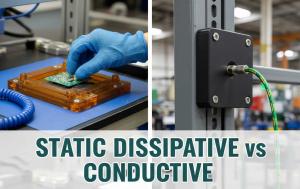Static Dissipative vs. Conductive Plastics Compared in New Interstate Plastics Technical Guide
Interstate Plastics’ new guide compares static dissipative and conductive plastics, explains ESD behavior, and simplifies material selection for buyers.
Choosing between static dissipative and conductive plastics shouldn’t require guesswork. We created this resource to give buyers a clear, technical comparison they can trust.”
SACRAMENTO, CA, UNITED STATES, October 15, 2025 /EINPresswire.com/ -- Interstate Plastics announced a new technical guide designed to help engineers, buyers, and operators quickly determine whether static dissipative or conductive plastics best suit their application. The guide explains how each material category controls electrostatic discharge (ESD), outlines key selection factors, and links to compatible product options.— Christopher Isar
ESD-sensitive environments (from semiconductor and electronics assembly to cleanrooms, packaging lines, and facilities handling flammable powders) often consider both static dissipative and conductive solutions because each can solve similar problems. Selecting the right one depends on understanding how the materials differ in surface resistivity, ESD behavior, grounding needs, cleanliness requirements, and intended use.
The guide breaks down the decision this way: static dissipative plastics bleed off charge in a controlled manner to protect sensitive electronics and reduce sudden discharges; conductive plastics provide a rapid path to ground when maximum conductivity, EMI/RFI shielding, or explosive‑risk mitigation is required. It also addresses practical considerations such as coating vs. compounded options, color and visibility needs, and whether carbon shedding or contamination control will impact the choice.
View the new resource outlining the differences between static dissipative and conductive plastics here: https://www.interstateplastics.com/static-dissipative-vs-conductive
Because of these differences, buyers typically use static dissipative materials for electronics handling trays, ESD work surfaces, cleanroom windows and enclosures, and conveyor components in sensitive manufacturing. Conductive materials are chosen for grounding components, ESD flooring tiles, EMI/RFI shielding housings, and fixtures in higher‑risk environments where instant charge equalization is critical.
Interstate Plastics developed this guide to make material selection faster and clearer. If you still need help, IP material experts are available to discuss your environment, performance goals, and part geometry—and recommend the most suitable option. Call (888) 768‑5759 for assistance.
Interstate Plastics is a full-line distributor of high-performance sheet, rod, tube, plate, and bar, and proudly serves many diverse industries, including OEM, semiconductor, food processing, POP display, government, agriculture, automotive, and many others. With 10 locations nationwide and an online sales and support team, Interstate Plastics provides full sheets and pallets, cut-to-size service, complex CNC, welding solutions, and full machining capabilities.
Interstate Plastics is known for selling high-quality products, providing excellent customer service, and providing superior technical support. Excellence in all facets of the customer experience has been the cornerstone of Interstate Plastics for over 45 years.
Stephen Sowinski
Interstate Plastics
+1 888-768-5759
email us here
Visit us on social media:
LinkedIn
Instagram
Facebook
YouTube
X
Legal Disclaimer:
EIN Presswire provides this news content "as is" without warranty of any kind. We do not accept any responsibility or liability for the accuracy, content, images, videos, licenses, completeness, legality, or reliability of the information contained in this article. If you have any complaints or copyright issues related to this article, kindly contact the author above.

